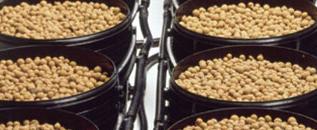We often receive requests for controllers for DIY hydroponic flood and drain irrigation systems, so in this article we will briefly introduce the flood and drain concept and explain how we put together controllers to manage the system.

In flood and drain systems collections of pots containing plants and a growing medium such as highly porous clay pebbles rather than soil sit on a tray. Water with added nutrients is flooded into the tray which rises up through the bottom of the pots saturating the growing medium and the roots of the plants. With large pots, the nutrient solution is piped directly into the bottom of the pots with no tray. The nutrient solution is then drained from the pots. This flooding and draining cycle is repeated multiple times every day. As the solution rises up through the dry pots it pushes the air out from the growing medium. Then as the solution drains out of the pots, fresh air is sucked into the growing medium bringing oxygen to help strong root growth.
For optimal plant growth there are three factors to consider – flood frequency, duration, and height. Flood frequency (how many floods per day) depends on the growth medium and the stage of growth of the plants. Flood duration (how long the pots remain flooded each time) depends on the growth medium. Flood height (how far up the pots the nutrient solution goes when flooded) is usually set to the top of the pot. These factors are very specific to individual systems so we will not cover them here.
The System

Pictured above is a not to scale schematic of a typical flood and drain system. We have come across many different system configurations, but this has been the commonest type we have worked on.
There is a reservoir which holds the nutrient solution, and a second container called the brain.